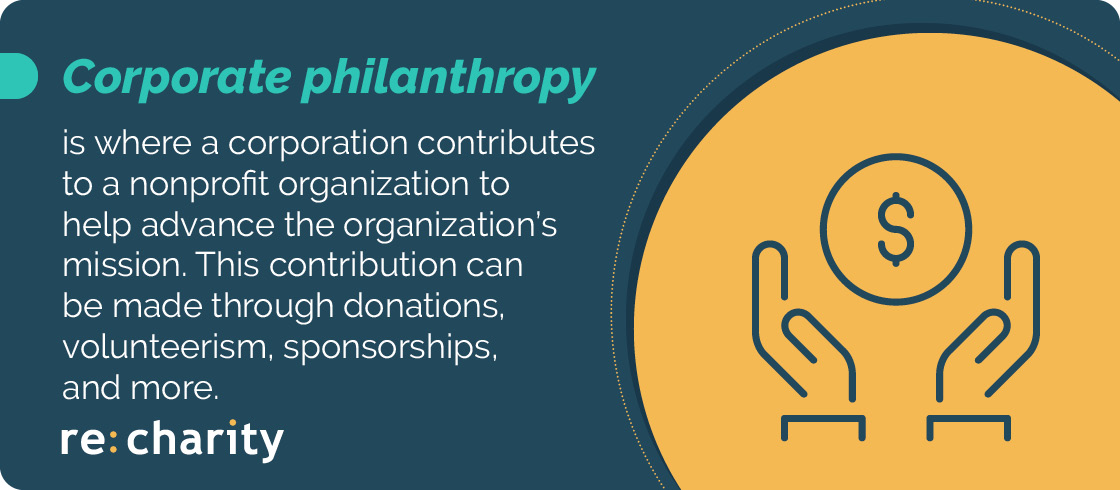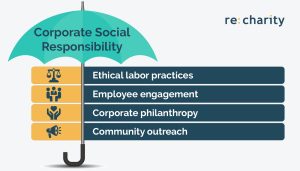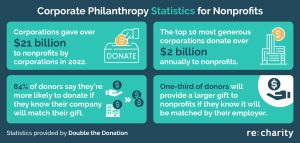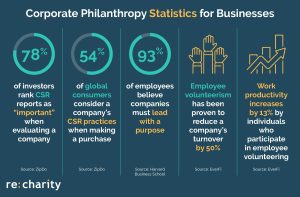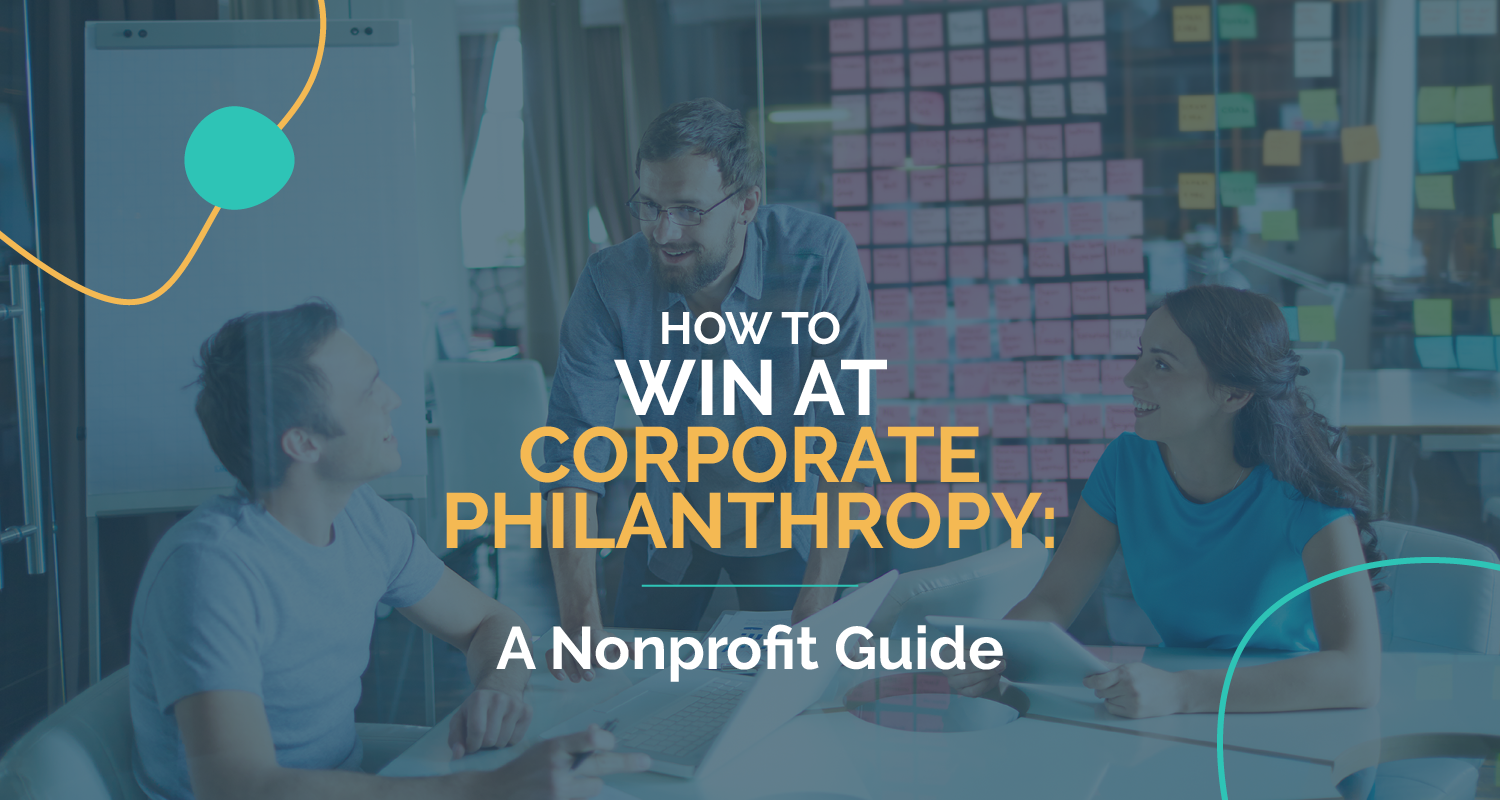
Nonprofits are always looking for new sources of funding. While individual donors do a great job of helping nonprofits stay up and running, another player that’s often overlooked is corporations. Many businesses offer programs to give back to their communities by investing in nonprofit organizations. This is a method of corporate philanthropy nonprofits can tap into.
The problem is that few nonprofits know how to take advantage of corporate philanthropy. That’s why we’ve created this guide: to help organizations learn about corporate philanthropy so they know where to look to find programs and how to make the most of them once they’re involved.
In this guide we’ll cover:
- What is corporate philanthropy?
- What are the different types of corporate philanthropy?
- What are the benefits of corporate giving programs?
- How can nonprofits promote corporate giving?
- What companies offer corporate philanthropy programs?
After reading through this resource, your nonprofit will be ready to leverage corporate giving to its fullest extent. Let’s get started!
1. What is corporate philanthropy?
Corporate philanthropy occurs when a corporation contributes to a nonprofit organization to help advance the organization’s mission. This contribution can be donations, volunteerism, sponsorships, and more.
Corporate Philanthropy vs Corporate Social Responsibility
Though related, corporate philanthropy and corporate social responsibility (CSR) are not the same. CSR describes a broader process where businesses take steps toward expanding their positive impact on social, environmental, and economic factors. Corporate philanthropy falls under the larger umbrella of corporate social responsibility.
Ethical labor practices, employee engagement tactics, corporate philanthropy, and community outreach are four common CSR contributions. Companies with a reputation for implementing these programs tend to experience significant benefits, as 77% of consumers are motivated to purchase from brands committed to making the world a better place.
That said, a company’s approach to CSR will vary depending on its goals and current capacity. For example, a company with limited resources should plan to start small with internal changes such as sustainable business practices or socially informed hiring practices. Then, once the company expands, it can sustainably explore more philanthropic CSR initiatives like matching gifts or volunteer grants.
Companies must review their CSR efforts often to make sure they align with their corporate values. An effective CSR program is a win-win-win—for businesses, their nonprofit partners, and society as a whole. For this reason, they might opt to work with a CSR vendor or CSR consultant to manage expectations and implement informed changes.
2. What are the different types of corporate philanthropy?
In total, there are hundreds of ways corporations can give back to nonprofit organizations. To get your nonprofit started, here are a few of the most common types of corporate philanthropy to look out for.
Matching Gifts
Companies with matching gift programs donate to “match” employee gifts to eligible nonprofits. Businesses typically make this contribution at a 1:1, but some offer a 2:1 or even 3:1 ratio!
This is the most common form of corporate giving and can be used to maximize the impact of each donation your nonprofit receives. If eligible donors don’t request a matched gift, it’s essentially leaving free money on the table.
To increase matching gift revenue, many nonprofits use matching gift software. These tools provide nonprofits with access to a matching gift database and a search function they can add directly to their donation page. This allows donors to look up their employer and see if their donation is eligible for matching right when they’re making their gift.
Here’s a look at how you can use matching gift software to boost your corporate philanthropy outreach:
360MatchPro 2-Minute Overview from Double the Donation on Vimeo.
Recent software developments such as 360MatchPro’s matching gift auto submission make this process even easier to complete by swapping manual submissions for automatic requests. This lets employees get their donation match requests completed in seconds and enables nonprofits to benefit from reliable matching gift support in just three simple steps:
- An employee makes a contribution directly to a nonprofit on their own website.
- The employee enters their email to submit their match automatically.
- The match request process is complete.
Without auto-submission, your nonprofit can experience roadblocks in earning matching gift revenue caused by time-consuming submissions and unaccounted-for requests. But with auto-submission, it’s easier than ever for nonprofits to encourage donors to take the extra step and bring in matching gift revenue.
Volunteer Grants
While matched gifts are donated by corporations when an employee gives to a nonprofit, volunteer grants are contributed when an employee volunteers for a nonprofit.
Corporate philanthropy programs outline the parameters of how many hours employees need to volunteer to be eligible for these grants. For instance, a corporation might offer to donate $100 per 20 hours an employee volunteers to an eligible nonprofit.
These grants encourage employees to volunteer more frequently at eligible nonprofit organizations.
Corporate Sponsorships
Companies frequently sponsor nonprofits to support their missions. Many companies sponsor specific nonprofit events or initiatives, though some provide ongoing support. While sponsorships are typically in the form of financial contributions, companies can also support nonprofits through in-kind or media sponsorships.
To show appreciation for their support, nonprofits thank and promote their sponsors publicly. They may also add a sponsor’s logo, branding, and company name to their website and relevant event materials.
For nonprofits looking for corporate sponsorship opportunities, start by contacting local businesses in your area share your organization’s values. Leverage connections your organization may have to certain businesses, such as an affiliation with one of your board members. You can also perform cold outreach by looking for potential sponsors online and contacting their human resources departments for help.
Other Types of Corporate Philanthropy
Other types of corporate philanthropy include:
- Corporate grants. Corporations provide monetary grants to fund nonprofit programs and projects. Usually, nonprofits apply by submitting a grant proposal that outlines how the nonprofit intends to use the money and why the nonprofit’s project aligns with the corporation’s philanthropic values.
- Employee Grant Stipends. Grant stipends are a set amount of money that corporations set aside for each of their employees. The employee decides where the stipend will be donated.
- Disaster Relief. Corporations often offer grants for disaster relief to help communities during times of crisis. Usually, communities must be in the same geographical area as the company to qualify for such grants.
- In-Kind Donations. Companies offer gifts of services or items to help nonprofits fill a need. For instance, a company may provide an in-kind donation of accounting services to a nonprofit in order to help them reconcile their accounts or file tax forms.
Corporate philanthropy is meant to help nonprofits and other charitable organizations succeed in their missions and provide an improved image for the company as a community-minded, socially conscious entity.
3. What are the benefits of corporate philanthropy programs?
Corporate philanthropy programs provide significant advantages for nonprofits and corporations alike. Some of these benefits are as follows:
Benefits for Nonprofits
For nonprofits, the benefits of corporate giving are fairly self-explanatory: it provides more funding for the organization. But how much funding can it really bring? According to Double the Donation’s matching gift and nonprofit fundraising statistics:
- Corporations gave over $21 billion to nonprofits by corporations in 2022.
- The top 10 most generous corporations donate over $2 billion annually to nonprofits.
- 84% of donors say they’re more likely to donate if they know their company will match their gift.
- One-third of donors will provide a larger gift to nonprofits if they know it will be matched.
From these statistics, it’s clear that corporate philanthropy is a revenue opportunity nonprofits should not ignore. Additionally, these programs bring other benefits to nonprofits, including:
- Greater outreach. Partnering with a corporation’s philanthropy program allows your nonprofit to reach new audiences. Specifically, you’ll have access to the corporation’s employees, who’ll learn more about your organization through the program and may even become long-time supporters.
- Word-of-mouth marketing. The business world is very connected. Once you establish partnerships with a couple of companies, your nonprofit’s mission can gain even more support.
- Volunteer recruitment. A common corporate philanthropy program is the volunteer grant, where the company donates to nonprofits that employees volunteer at. This encourages employees to volunteer with your organization, helping you recruit more volunteers for your mission.
- Relationship building. Not only will you build relationships with employees, but a successful corporate philanthropy partnership may lead to more opportunities down the road, including sponsorships.
Corporate philanthropy is extremely beneficial for nonprofits in a variety of ways. It’s well worth it to research companies near you with these programs and to ask to become their partners.
Benefits for Corporations
Not only does corporate philanthropy help nonprofits succeed in their missions, but it also helps the companies that offer these programs. When employees take advantage of corporate giving opportunities, the company sees advantages such as:
- A positive image. By partnering with nonprofits, corporations earn recognition from the community for the positive change they’re working to make in the world.
- Better engagement from employees. Employees feel more engaged at work when they know their employer is making a positive difference in the world. More engaged employees tend to outperform those who aren’t engaged by a landslide.
- Encouraging a feeling of community. Employees who work together to help a nonprofit achieve its mission create a feeling of camaraderie at the office. This will lead to a more communal working environment for the corporation.
Unfortunately, many employees don’t take advantage of their employers’ corporate philanthropy programs, meaning neither party sees these incredible advantages.
Generally, this occurs because employees don’t know about the opportunities they have to make their contributions go further. That’s why it’s important to educate supporters about these opportunities and draw attention to them, as we’ll discuss more in the next section.
4. How can nonprofits promote corporate giving?
While some employers actively share corporate giving opportunities avaible to employees, many let it fall by the wayside. This means it’s up to nonprofit to educate donors about their potential elgibility for corporate giving programs.
Luckily, there are plenty of ways nonprofits can promote corporate giving opportunities. For example, an organization can encourage its supporters to leverage corporate philanthropy in the following ways:
Nonprofit Email Marketing
Use email marketing software to draft emails to send out to corporate partners informing them about corporate giving opportunities. Then, link to your corporate giving page or donation page to make it easy to access more information.
Tailor each email to the business recipient, so they can find valuable information. For instance, you could provide a link to a recent blog post that discusses how to engage and motivate employees through corporate philanthropy or one that explains your most popular corporate volunteer opportunities.
Website Content Marketing
Creating a dedicated corporate philanthropy page on your site is an effective marketing technique for informing supporters about the various corporate giving programs they may qualify for. Doing so will enable you to offer a comprehensive explanation of your programs while explaining how a business can benefit from partnering with you. Here are a few elements that will enhance your page:
- A clear, concise overview of your nonprofit’s mission and intentions for using corporate funds, including the types of corporate partners you seek and how they help you accomplish your goals.
- An educational section that informs corporate partners of your available corporate programs and associated instructions (in-kind donation restrictions, matching gift FAQs, corporate volunteer days, etc.) and how to get in touch with your organization.
- Social proof such as testimonials that speak to the value of collaborating with your nonprofit. Include logos from your current corporate partners to build trust.
- Contact information for someone at your nonprofit businesses can contact to set up official partnerships.
Once your page is live, use your other channels to promote it. By taking a multi-channel marketing approach, you’ll be able to expand your reach and engage corporate audiences across several different channels simultaneously.
Social Media Marketing
Support your email and website content marketing with social media. Define your target audience and post on platforms they regularly use, such as LinkedIn or Facebook. Post images of your new programs in action to inspire more support. For instance, you could post photos of corporate volunteer teams or a personalized thank you to corporate partners who helped you hit your matching gift goals.
Make your content as shareable as possible. Infographics, compelling video content, and thought-provoking articles are all great options to inspire your corporate partners to take action and join you in your mission.
Search Ads
Search engine marketing can boost your nonprofit’s online visibility and connect you with supporters who are eligible for corporate giving programs. While for-profit organizations need to spend their marketing budgets buying ad space, the Google Ad Grant program offers a transformative search marketing opportunity that registered 501(c)(3) nonprofit organizations should take full advantage of.
Through this grant program, Google offers $10,000 worth of free ad credits to nonprofits every month. Nonprofits can create ads to promote their website’s landing pages using their grant funding and find passionate supporters searching for corporate philanthropy opportunities.
Here’s a closer look at how it works:
Let’s unpack how you could use the Google Ad Grant to promote a corporate philanthropy-specific landing page on your website:
What are Google Ad Grants? from Getting Attention on Vimeo.
- Conduct keyword research to identify terms businesses are looking for like “corporate environmental partnerships.”
- Create a keyword optimized landing page that explains your relevant programs and how businesses can get involved.
- Use your Google Ad Grant to create a compelling ad campaign that targets this keyword and leads to your landing page.
- These relevant ads appear at the top of Google’s search results page where interested corporate partners can easily find them.
Search ads are the perfect way to put your nonprofit in front of those searching for corporate partnership opportunities online. However, if you’re new to the Google Ad Grant program, the application process and ongoing maintenance can be a bit involved. That’s why you should consider reaching out to a Google Ad Grants manager for expert advice.
Business Networking and Outreach
Networking is the key to success in business, so it should come as no surprise that it holds true for philanthropic outreach as well. For business networking, you’ll want to zero in on how corporate philanthropy can benefit each business’s current CSR program.
If you’re just getting started, here are a few steps you can take to network with relevant businesses:
- Research businesses that have philanthropic missions, values, and CSR goals that align with your nonprofit objectives.
- Organize CSR events or discussions to bring businesses together to discuss the importance of CSR initiatives.
- Propose employee engagement options such as volunteer days, skills-based volunteering, or mentorship programs.
Seek mutually beneficial partnerships every step of the way and remember to reinforce the corporate advantages of philanthropy. For instance, you could mention these recent statistics to back your CSR appeals:
- 78% of investors rank CSR reports as “important” when evaluating a company.
- 54% of global consumers consider a company’s CSR practices when making a purchase.
- 93% of employees believe companies must lead with a purpose.
- Employee volunteerism has been proven to reduce a company’s turnover by 50%.
- Individuals who participate in employee volunteer are 13% more productive.
To continue cultivating corporate relationships, make sure to promptly thank supporters following a volunteer day, matching gift donation, or any other kind of corporate-backed support.
5. What companies offer corporate philanthropy programs?
There are a surprising number of corporate philanthropy programs out there, and a surprising number of them go unused. In fact, $4 to $7 billion in matching gift revenue goes unclaimed every year!
It’s always worth asking donors to check if their companies offer employee giving programs. Here’s an overview of some of the major companies that offer matching gift programs:
| Company | Match Ratio | Minimum Match | Maximum Match |
|---|---|---|---|
| 1:1 | N/A | $10,000 | |
| Coca-Cola | 2:1 | $25 | $20,000 |
| Home Depot | 1:1 | N/A | $3,000 |
| Chevron | 1:1 | $20 | $10,000 |
| IBM | 1:1 | $25 | $10,000 |
| FM Global | 2:1 | $25 | $8,000 |
Of course, there are tons of other companies that also offer these types of programs. And you never know who might sponsor your nonprofit! It’s always worth checking a matching gift database or reaching out for potential sponsorships. You never know what you might find.
Where can I find more information about corporate giving?
There are plenty of additional resources your nonprofit can use to learn more about corporate philanthropy. Tons of providers in the nonprofit space know the benefits of corporate giving and want to encourage organizations to take advantage of it.
Here are some of the additional articles that we’ve written here at Re:charity:
- The Top 20 Matching Gift Companies | Our Favorite Picks [Updated 2023]. Here’s a list of our favorite matching gift companies. Plus, we’ve included the parameters for each of their programs.
- Matching Gifts: The Ultimate Guide for Nonprofits in 2023. If you have specific questions about matching gifts, our Q&A guide likely has the answers you need.
- What is the Best Matching Gift Database? Our Reviews of Double the Donation, Affinaquest’s HEPData, Amply, and MatchFinder [Updated 2023]. We’ve analyzed the top matching gift database options in the industry and reviewed each to find the best one for nonprofits (hint: it’s Double the Donation).
